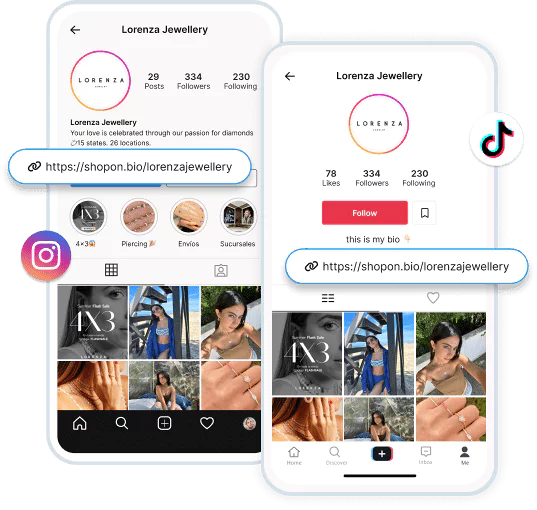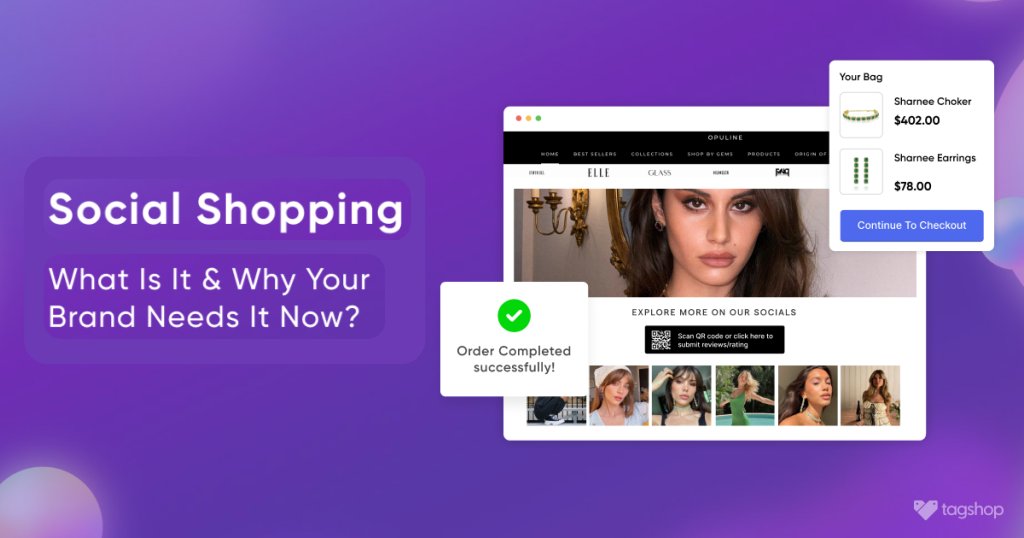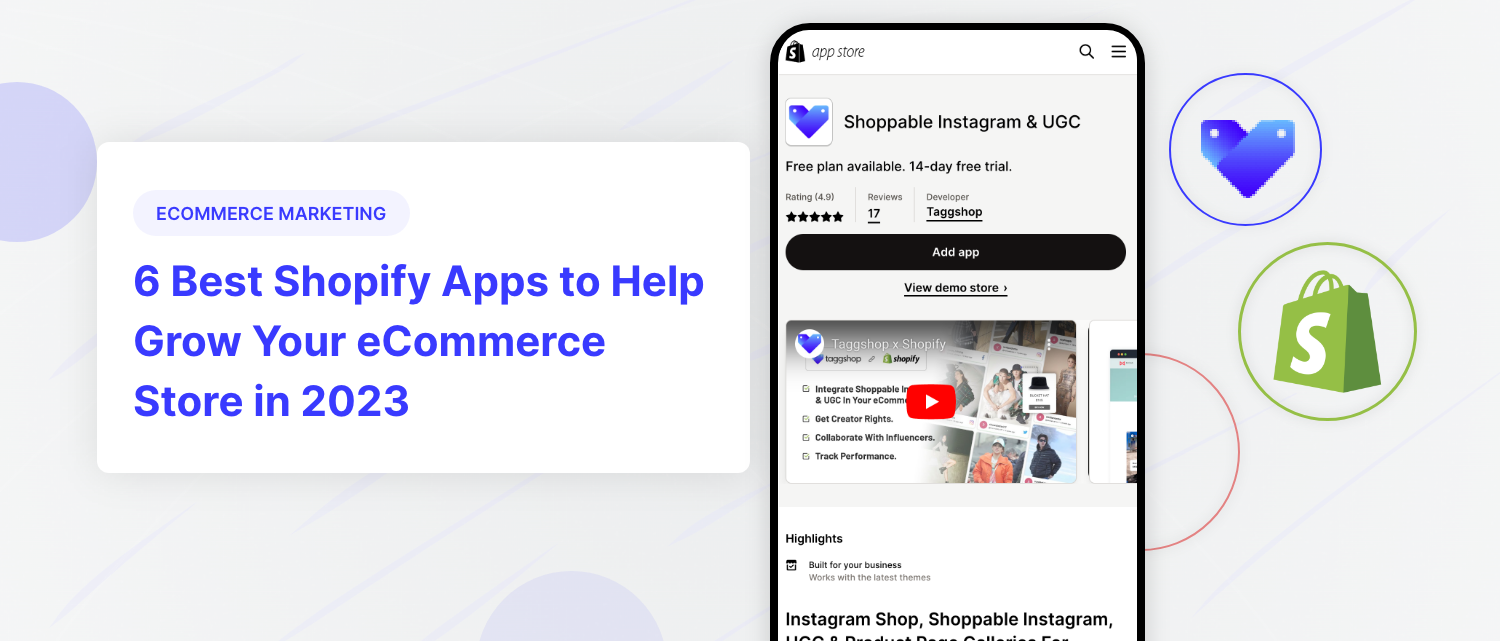What is Social Shopping? How It Is a Game Changer For E-commerce?
Customers are becoming more comfortable with exploring social media to fulfill their shopping desires and social shopping in 2025 is becoming the strategy that brands need to crack this game.
Millions of people explore social media platforms daily to get inspiration about what they can shop, trends, & more. For this reason, brands are utilizing their social presence to transform their e-commerce stores into engaging displays of shoppable social content.
This strategy is a must for all brands selling products (or even services) digitally because social shopping is truly the strategy of 2025.
In this blog, let’s explore the concept of social media shopping, social shopping definition, and some successful examples to get started with your social shopping strategy.
What is Social Shopping?
Social shopping is a social-forward way of shopping that leverages content from social media platforms like Instagram, TikTok and Facebook to influence buying decisions and streamline the shopping experience.
In simple terms social shopping allows users to directly buy products from social media content displayed on e-commerce touchpoints, such as web pages, product pages, or in emails.
Social shopping focuses on the simple combination of e-commerce and social media which makes it lucrative for brands to integrate this strategy.
“In a nutshell, social media shopping facilitates a confident shopping experience and easy checkout process, making shopping a breeze for consumers.”
Now that we know what is social shopping, let’s move on to understand why e-commerce brands need social shopping in 2025.
Why E-commerce Brands Need Social Shopping?
Commerce has taken a total shift from retail to digital, and a major chunk of the credit for this change can be attributed to the rise of social media. Social media has flourished significantly over the years, changing the consumer mindset and their expectations from businesses with user numbers anticipated to exceed 5.8 billion by 2027.

The era of traditional advertising is long gone when consumers knew what they wanted and trusted the brand’s portrayal of their products.
Modern consumers seek more than just a transactional experience; they crave inspiration, engagement, and a sense of confidence in their purchase decisions.
This shift in consumer mindset has made it mandatory for e-commerce businesses to incorporate social shopping in their strategy.

Here are some problems that social shopping is solving for e-commerce businesses, making it a must-have strategy for businesses.
1. Instilling Brand Trust & Credibility
User-generated content is the most powerful form of social proof, as real users create it based on their genuine experiences. With the help of shoppable UGC galleries, e-commerce businesses can easily establish brand trust and credibility. Customers can not only discover products through social content, but also make their purchases directly from the authentic visuals(images & videos) integrated into the e-commerce.
2. Improving the Dwell Time Significantly
A common point of challenge e-commerce businesses face is poor dwell time of consumers on important or transactional landing pages. By implementing social shopping strategies, brands can use the influence of social content to hold consumers for longer periods. Brands can integrate compelling shoppable galleries of social content into important e-commerce touchpoints, giving customers something to engage with.
3. Making Decision Making Easier
Social shopping is backed by social content, making it a more visual and engaging way of shopping for consumers. Incorporating social media shopping can help consumers make purchase decisions more confidently as businesses can provide shopping inspirations with Shop The Look and showcase their offerings through authentic and visually appealing social content integrated in all the right places.
4. Reducing Cart Abandonment Rate
The highest said barrier between a sale and an incomplete purchase is an unconvinced consumer. With the help of social shopping, e-commerce businesses can convey their brand offerings visually appealing yet transactionally, reducing the cart abandonment rate immensely. They can integrate their feed of shoppable social content into important landing pages, making the journey from product discovery to purchase seamless and quick.
5. Improving Customer Engagement
Statistics show that 91% of consumers prefer visuals over textual information. That brings in the importance of visual marketing – the key element to social shopping. If executed correctly, social content can improve customer engagement rate by at least ten times, making it a vital strategy for e-commerce businesses.

Social Shopping Vs. Traditional E-commerce
| Traditional E-commerce | Social Shopping |
| Trust is built through branded reputation, marketing efforts, and product descriptions. | Relies solely on user-generated content like reviews, ratings, and authentic testimonials that build trust and credibility. |
| Relies on users for product discovery with limited emphasis on personalized recommendations or external inspiration. | It uses interactive strategies, such as collaborating with influencers, to help create a unique brand image and reach specific target audiences. |
| Relies on strategies like branding, guerilla marketing campaigns, and product positioning in a competitive market. | It relies solely on user-generated content like reviews, ratings, and authentic testimonials that build trust and credibility. |
| The purchase journey is more manual and without much interaction. Customers find products on their own and go through the entire purchase journey. | The purchase journey is more interactive. Customers discover and purchase products through integrated social media content. |
| Limited engagement beyond product browsing and purchasing. | Higher customer engagement with a more visual interface, customers discovering products through social media content. |
Best 5 Strategies To Leverage Social Media Shopping
Leveraging social media shopping is a highly effective strategy to build a successful e-commerce brand. With social shopping as the base of your e-commerce marketing efforts, businesses can flourish with a more engaged audience, improved sales, and a stronger brand overall.
1. Be Consistent With Your Content
Consistency is key in social media shopping. Create a cohesive brand image by consistently rotating the social content posted on your website. Maintain a consistent visual style, tone, and posting schedule across your social channels and e-commerce touchpoints.
This consistency helps in brand recognition and establishes trust with your audience. When users see consistent and fresh posts, they are more likely to engage with your content and recognize your products instantly.
2. Turn Users’ Content Into Shoppable UGC
The most important element of crafting social media shopping strategies is not overlooking user-generated content (UGC). UGC is a powerful tool in social shopping, as it can help businesses showcase products more realistically.
By making this content shoppable by integrating product tags into the content, users can boost social proof and turn user-generated content into a valuable asset for driving sales.
3. Strategize Your Content Creation & Distribution
Social media is a fairly simple strategy that numerous brands are implementing. However, with social shopping, developing a well-thought-out content strategy that aligns with your brand goals and resonates with your target audience is the real deal.
Before proceeding, consider the types of content that perform well on each platform and personalize your strategy accordingly. Prioritize high-quality visuals, compelling product descriptions, and a clear call to action to drive users toward making a purchase.
4. Don’t Forget to Get UGC Rights
Another important social shopping strategy is to do it the right way. Before featuring user-generated content on your e-commerce website, ensure you have obtained the rights and permissions from the creators to utilize this content.
The creator might have created content about your brand, but that still doesn’t give you the right to use it. This step is crucial for legal compliance and maintaining a positive customer relationship. Communicate your intentions when seeking permission and provide credit to the content creators whenever applicable.
5. Showcase Your Products Naturally
Social media is meant for leisure – Users do not want content aimed at increasing sales & promotions. When showcasing your products on social media, put out a natural front for an authentic presentation of your brand. Even, if you’re in a pinch with a last minute presentation, focus on keeping the content genuine, letting your product shine without pushing too hard. To make the best presentation AI work for you, focus on creating clear, engaging visuals that truly reflect your unique identity.
Share content that has a purpose, provides value, and showcases your products naturally as part of the scene so that consumers feel curious about it. Authenticity resonates with users and can lead to higher engagement and trust, ultimately contributing to successful social shopping experiences.
Social Shopping Examples: Take Inspiration From These E-Commerce Use Cases
Implementing social shopping in 2025 for your brand is a need more than a want. This strategy has created a difference for several e-commerce brands globally.
In this section, let’s go through a few social shopping examples and take a look how they have displayed social content on their various e-commerce touchpoints:
1. Eureka Street Furniture
Eureka Street Furniture is an e-commerce consumer goods brand dealing in furniture and home decor. The brand is one of the best social shopping examples for intricately using social content to help customers visualize the products in action as well as provide them the confidence to invest in the products.

Eureka Street Furniture’s social shopping strategy is a great example of how e-commerce businesses, irrespective of their niche and industry can use this strategy to gain more revenue and ROI.
2. French Kande Jewelry
If you are a fashion or jewelry e-commerce brand, French Kande’s social shopping strategy is the perfect example of how you can use your compelling social content to not only create a beautiful shopping experience but increase sales significantly.

French Kande Jewelry has integrated a shoppable feed of social content into their homepage. This integration has successfully helped them achieve 3X more engagement and improved dwell time on their website. Moreover, the shoppable tags in the content has made the purchase journey faster, reducing cart abandonment rate.
3. Cluse
Another one of the best social shopping examples is Cluse, a popular watch and accessory brand utilizing its social content on Instagram to showcase its products in an authentic light.

The brand has a shoppable feed integrated on their homepage that allows customers to discover products easily and shop them more seamlessly. This strategy of social content integration has helped the brand generate more sales and visibility and build a more engaged audience.
How to Use Social Shopping Features On Different Platforms?
In the previous section, we discovered how some popular e-commerce brands utilize social shopping platforms to improve their brand visibility and sell more. Now, let us find out how this brilliant strategy can be used on different platforms:
1. Social Shopping on eCommerce Website
For e-commerce brands, a website is the most important front, which has the potential to retain visitors and turn them into customers. Brands can utilize engaging influencer content, branded content, etc, to showcase their products more compellingly.
Additionally, brands can turn this content shoppable using tools like Tagshop. E-commerce businesses can also integrate reviews and ratings to establish trust and allow customers to purchase products directly from this content.
2. Social Shopping on Facebook Page
Along with being a social media giant, Facebook is also a leading marketing tool and e-commerce platform. Businesses can utilize Facebook for social shopping by setting up virtual storefronts on Facebook, showcasing their products, and allowing users to browse and purchase directly within the platform.
Due to the platform’s familiarity among the masses, businesses can leverage the already-established trust of the platform and run ads featuring products with shopping tags that lead users to purchase directly.
3. Social Shopping in Email Campaigns
Marketing is an essential part of running a business. Even in today’s high-competition e-commerce industry, email marketing remains supreme.
By integrating social shopping in emails, brands can send out personalized product recommendations based on users’ browsing and purchase history, allowing customers to discover products and shop them directly within the email.
4. Social Shopping on Instagram
Instagram is known for its visually-forward interface and its focus on providing top-notch content creation features. But what we often miss out on is the platform’s e-commerce tools and features. By integrating social shopping with Instagram, brands can tag products in their posts and stories, allowing users to click through and purchase directly within Instagram. If your business is not compatible with Instagram Shop’s eligibility criteria, you can still activate it with Tagshop’s Shopon Bio.
What’s Shopon.bio? It is a feature by Tagshop that allows brands to curate a shoppable link in bio store, featuring social content showcasing your products. Brands can easily use this shoppable link in Instagram’s bio section to activate social shopping.

What is the Future of Social Shopping?
The e-commerce industry is growing like never before. According to statistics, around 2.77 billion people are expected to shop online by 2025. This proves that there is a vast market waiting to be captured.
But how?
Even though the competition is tough, user experience is one factor that can help any business stand out and make its mark. This is when social shopping comes in. With social shopping, businesses can streamline users’ shopping experience, allowing them to act more efficiently on your products.
Final Thoughts
Whether you are using social shopping to display user-generated content or providing users with eye-catching offers to choose your brand, social media shopping is an impressive strategy to get the best ROI on your marketing.
By social shopping we can leverage authentic user-generated content, influencer collaborations, and branded campaigns within social media platforms to guide users seamlessly towards making purchases.
Additionally, social shopping is the key to expanding your brand beyond the established e-commerce channels and enhancing customers’ experience. This marketing trend is the gem of the marketing system and has paved the way for increased sales and conversions.
Frequently Asked Questions
Social shopping is a strategy that focuses on using social media content from platforms like Instagram and Facebook as a medium for users to shop and discover products on e-commerce sites.
By social shopping we can leverage social media content to create an immersive shopping experience. Users can explore products, receive recommendations, and make purchases directly through the feed of social content integrated on e-commerce touchpoints like the homepage, product pages, etc.
A social shop refers to an online store or platform that incorporates social elements, enabling users to engage with products, and make informed purchase decisions in a collaborative environment.
Social shopping is continually evolving and is expected to remain a significant trend in 2025. With the increasing integration of AI, augmented reality, and personalized experiences social shopping will grow even further to enhance user engagement and shopping experiences.










